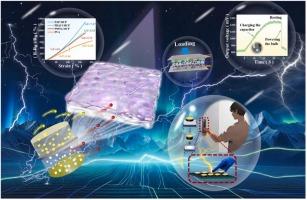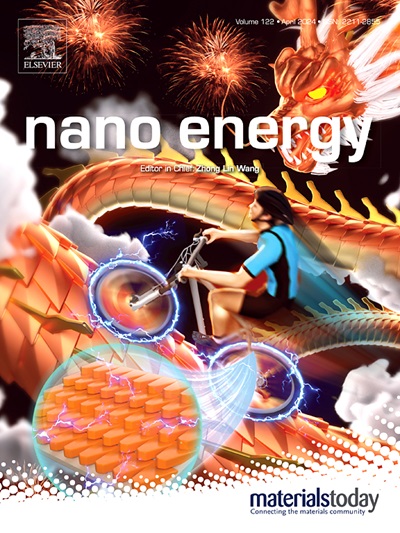A diode-like integrated hydrogel for piezoionic generators and sensors
IF 16.8
1区 材料科学
Q1 CHEMISTRY, PHYSICAL
引用次数: 0
Abstract
Wearable sensing electronic devices based on hydrogel are gradually developing towards multifunction and portability, however, efficiently harvesting energy from the surrounding environment to power traditional hydrogel-based wearable electronic devices is a major challenge. The assembly of multilayer heterogeneous hydrogels is a potential strategy to address this challenge. Herein, inspired by the structure of diodes, a diode-like integrated hydrogel composed of a three-tier structure of anionic polyelectrolyte hydrogel, polyacrylamide hydrogel and cationic polyelectrolyte hydrogel is developed. By the connection of polyacrylamide hydrogel, the composite hydrogel exhibits excellent structural stability and mechanical properties. Notably, due to the introduction of MXene ion-conducting microchannels, the directional transport of free cations and anions ionized by anionic and cationic polyelectrolytes is achieved, thereby improving the conductivity (74.58 mS/cm), sensing (gauge factor = 7.47) and piezoionic output performance of the composite hydrogel. The composite hydrogel-based sensor can sense tiny facial movements and recognize the direction of human movement, and the composite hydrogel-based piezoionic generator exhibit more efficient mechanical-electric conversion performance, which can output the maximum voltage of 1410 mV, current of 28 μA, and power density of 2.9 mW/m2 for a composite hydrogel of 5×5 cm2. The integration of multilayer heterogeneous hydrogels proposes a versatile strategy for the development of high-performance hydrogel-based self-powered sensing electronic devices, expanding the application of hydrogels in artificial intelligence and human-computer interaction.

用于压电发生器和传感器的二极管状集成水凝胶
基于水凝胶的可穿戴传感电子设备正逐渐向多功能和便携性方向发展,然而,如何有效地从周围环境中收集能量,为传统的基于水凝胶的可穿戴电子设备提供动力,却是一项重大挑战。组装多层异质水凝胶是应对这一挑战的潜在策略。本文受二极管结构的启发,开发了一种类似二极管的集成水凝胶,由阴离子聚电解质水凝胶、聚丙烯酰胺水凝胶和阳离子聚电解质水凝胶三层结构组成。通过连接聚丙烯酰胺水凝胶,复合水凝胶表现出优异的结构稳定性和机械性能。值得注意的是,由于引入了 MXene 离子传导微通道,阴离子和阳离子聚电解质电离出的游离阳离子和阴离子实现了定向传输,从而提高了复合水凝胶的传导性(74.58 mS/cm)、传感性(测量系数 = 7.47)和压电输出性能。基于复合水凝胶的传感器可以感知微小的面部动作并识别人体运动方向,而基于复合水凝胶的压电发生器则表现出更高效的机电转换性能,在 5×5 cm2 的复合水凝胶中可以输出 1410 mV 的最大电压、28 μA 的电流和 2.9 mW/m2 的功率密度。多层异质水凝胶的集成为开发基于水凝胶的高性能自供电传感电子装置提出了一种通用策略,拓展了水凝胶在人工智能和人机交互领域的应用。
本文章由计算机程序翻译,如有差异,请以英文原文为准。
求助全文
约1分钟内获得全文
求助全文
来源期刊

Nano Energy
CHEMISTRY, PHYSICAL-NANOSCIENCE & NANOTECHNOLOGY
CiteScore
30.30
自引率
7.40%
发文量
1207
审稿时长
23 days
期刊介绍:
Nano Energy is a multidisciplinary, rapid-publication forum of original peer-reviewed contributions on the science and engineering of nanomaterials and nanodevices used in all forms of energy harvesting, conversion, storage, utilization and policy. Through its mixture of articles, reviews, communications, research news, and information on key developments, Nano Energy provides a comprehensive coverage of this exciting and dynamic field which joins nanoscience and nanotechnology with energy science. The journal is relevant to all those who are interested in nanomaterials solutions to the energy problem.
Nano Energy publishes original experimental and theoretical research on all aspects of energy-related research which utilizes nanomaterials and nanotechnology. Manuscripts of four types are considered: review articles which inform readers of the latest research and advances in energy science; rapid communications which feature exciting research breakthroughs in the field; full-length articles which report comprehensive research developments; and news and opinions which comment on topical issues or express views on the developments in related fields.
 求助内容:
求助内容: 应助结果提醒方式:
应助结果提醒方式:


